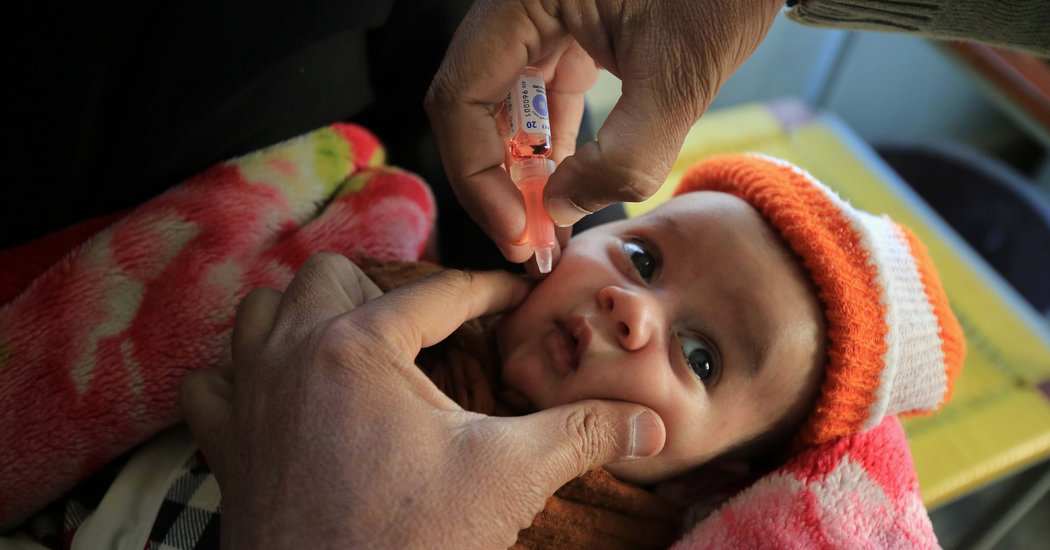
The widespread interruption of routine immunization programs around the world during the coronavirus pandemic is putting 80 million children under 1 year old at risk of contracting deadly, vaccine-preventable diseases, according to a report Friday by the World Health Organization, UNICEF and Gavi, the Vaccine Alliance.
The groups surveyed 129 poor and middle-income countries and found that 68 had some degree of disruption of vaccine services through clinics and through large inoculation campaigns.
Measles initiatives, for example, have been suspended in 27 countries, including Chad and Ethiopia, and polio programs are on hold in 38, including Pakistan and the Democratic Republic of Congo.
Many public health experts say they are worried that deaths from diseases including cholera, rotavirus and diphtheria could far outstrip those from Covid-19 itself.
The report highlighted warnings about polio, which had recently been all but eradicated, a hard-won victory that resulted from mass immunization programs that reached millions of children.
Dr. Seth Berkley, chief executive of Gavi, said that developing countries had made big gains in immunizations against numerous diseases in recent years. Before the pandemic hit, he said, more children in more countries had been protected against more vaccine-preventable diseases than ever before.
“Due to Covid-19, this immense progress is now under threat, risking the resurgence of diseases like measles and polio,” he said.
Restarting immunization programs is crucial not just for preventing more outbreaks of life-threatening diseases, he said: “It will also ensure we have the infrastructure we need to roll out an eventual Covid-19 vaccine on a global scale.”
The problem of slipping vaccine rates is not limited to developing countries. This week, the Centers for Disease Control and Prevention reported that coverage rates among Michigan infants had dropped below 50 percent for all childhood immunizations. New York City announced that during a six-week period of pandemic lockdown, the number of vaccine doses administered to children dropped 63 percent, compared with the same period last year.
According to health ministers and medical providers in the countries surveyed, there are a number of reasons for the disruptions.
In late March, up to 80 percent of flights to Africa that deliver vaccines and syringes were canceled. The health care workers who administer vaccines have been afraid to proceed with the supplies they have on hand, because they lack sufficient protective gear. Parents have been afraid to take children to health clinics. Many areas are in lockdown altogether. And thousands of health care workers who might otherwise be engaged in vaccination are being diverted to respond to Covid-19.
International public health experts, including the W.H.O., had initially recommended that mass vaccine programs in particular be halted while the pandemic raged to protect against further spread occasioned by long lines of children waiting for shots.
But officials are now moving toward a cautious risk-benefit analysis. Noting that Covid-19 has flared inconsistently worldwide, varying not only from country to country but also within national borders, the Global Polio Eradication Initiative, a consortium of international organizations, is urging countries to evaluate their own situations closely and devise alternative, pandemic-safe vaccination strategies as soon as possible.
Because of the pandemic, Nigeria, which had been well on track to be certified as free of wild polio virus, had to cancel two polio vaccine campaigns in targeted areas that would have otherwise immunized a total of 37.6 million children.
The Nigerian campaigns required that health care workers go door-to-door. “We couldn’t expose vaccinators,” explained Dr. Anis Siddique, the head of immunization for UNICEF in Nigeria, about why the programs were suspended.
A similar report last month that focused just on the suspension of measles and rubella immunization campaigns already sounded an alarm.
Before the coronavirus pandemic, measles cases were already rising. In 2017, there were 7,585,900 estimated measles cases and 124,000 estimated deaths, according to the World Health Organization. In 2018, the last year for which international figures have been compiled, there were 9,769,400 estimated measles cases and 142,300 related deaths.
In 2019, the United States reported 1,282 measles cases, its highest in more than 25 years.
“Prior to Covid, measles was moving across the world as people flew,” said Dr. Frank Mahoney, an immunization expert and medical epidemiologist with the International Federation of Red Cross and Red Crescent Societies. “With more and more children becoming susceptible to it, it could be amplified and become a major international problem.”
Henrietta Fore, the executive director of UNICEF, addressed the terrible calculus countries must make in determining how to proceed. “While circumstances may require us to temporarily pause some immunization efforts,” she said, “these immunizations must restart as soon as possible, or we risk exchanging one deadly outbreak for another.”
